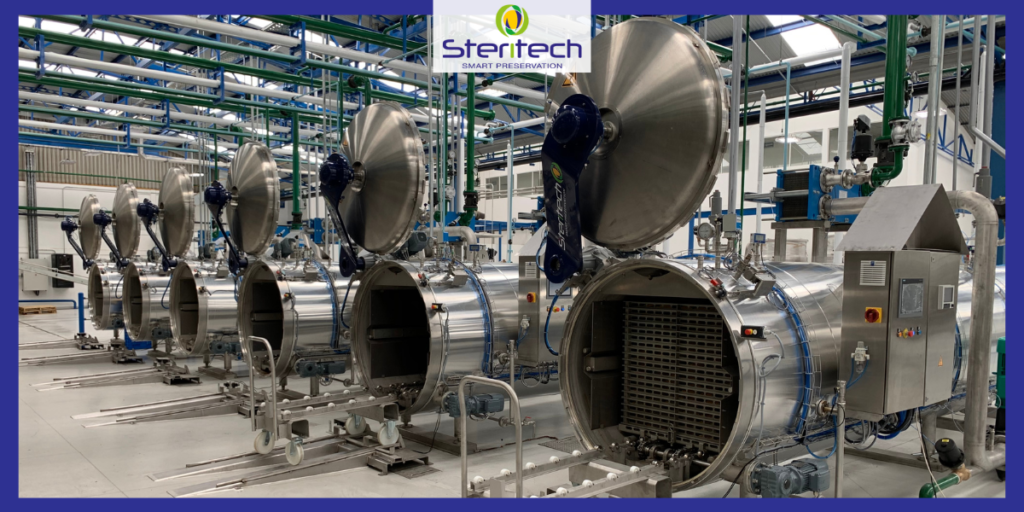Everything you need to know about all the types of autoclaves

What are the different types of autoclaves?
Preserving food and sterilizing medical equipment is an important concern in industry. With the discovery of pathogenic bacteria and microorganisms, the need to sterilize products has become increasingly important, especially in the food and medical industries. There are several types of autoclaves for food and medical sterilization. Learn more about how autoclaves work and how our autoclaves can help your business.
How does an autoclave sterilization work?
Autoclave sterilization requires a 5-step sterilization cycle. Also, the use of an autoclave also requires regular machine checks.
The different steps of a sterilization cycle
Let’s review the sterilization cycle.
Cycle step 1: autoclave purging and filling process
The first step in a sterilization cycle is to evacuate air from the autoclave. This is necessary to evenly distribute heat throughout the autoclave.
Cycle step 2: autoclave temperature rise
The second step brings the autoclave up to temperature. This step is associated with a back pressure. As the temperature of the product rises, the pressure inside the package increases. Compressed air is added to prevent deformation of the package.
Cycle step 3: autoclave temperature maintenance
The sterilization temperature maintenance step is the most important and critical phase of heat treatment. The time/temperature pairing is mandatory.
Cycle step 4: autoclave cooling process
The autoclave cooling phase depends on the amount of cold water injected and the products being sterilized. It reduces the temperature of both the autoclave and the products.
Cycle step 5: autoclave drain phase
During this last phase, the water is removed from the autoclave. The remaining air is expelled to return to atmospheric pressure.
How do you control your autoclave sterilization cycle?
First, the parameters to be controlled are temperature, pressure and time. Second, the heat treatment is evaluated by the Sterilization Value (F0) or Pasteurization Value (Fp). It measures the intensity of the technical treatment. It is calculated using a temperature probe placed in the heart of the product. The F0 or Fp is used to check that the heat treatment is proceeding correctly and to determine the time-temperature pairing for the plateau phase. This value depends on the type of product and the number of microorganisms initially present.
What are the materials and equipment of an industrial autoclave?
Autoclaves consist of a sterilization chamber with a lid. They are made of stainless steel and come in different sizes depending on the type of products to be sterilized. Autoclaves are equipped with temperature and pressure control instruments. An improved industrial version of the electric sterilizer, this sterilizer is subject to pressure vessel regulations. It is equipped with safety devices that are subject to periodic inspection.
The different autoclave sterilization agents
Autoclave sterilization uses different types of sterilizing agents:
- water;
- steam;
- saturated steam.
Temperatures and pressures may vary depending on the type of product being sterilized. The temperature and the pressure are adjusted to each product for precise sterilization. In this way, the product is microbiologically safe.
List of the different types of autoclave for sterilization
Let’s take a look at the different types of industrial autoclaves and how they are used for sterilization.
Steam autoclave sterilization
This type of autoclave uses a mixture of air and steam for sterilization. This mixture preserves the packaging. Cooling is achieved through top and side nozzles that spray water on the products. The temperature is evenly distributed inside the chamber thanks to the turbine at the bottom of the autoclave, which allows the steam to circulate.
Water spray autoclave for sterilization
This type of autoclave sprays pressurized water onto the products to be sterilized. Depending on the sterilization cycle, this water is heated by steam and then cooled by an exchanger. This economical autoclave recycles water during the cycle. The heat is optimally distributed throughout the unit.
Product sterilization through bi-process autoclaving
This type of autoclave combines the two processes of steam air and water spray. The heat is distributed inside the vessel. This speeds up the temperature rise and settling phases. Ideal for high capacity autoclaves.
The immersion autoclave to sterilize your products
The immersion autoclave works in the same way as the popular canner sterilizers. The products to be sterilized are covered with superheated water, which increases in temperature and pressure according to the dedicated cycle.
At Steritech we offer you different types of autoclaves for the sterilization of your products. Depending on the products that need to be sterilized, Steritech offers you a solution. For small structures, let our Goût’Stave autoclave do the job! This horizontal autoclave has a water or air/steam spraying process. Thanks to our Trilogy software, Goût’Stave is a self-contained autoclave.
For industry, Steritech offers different types of autoclaves: a water spray autoclave, an air-steam process autoclave, a bi-process autoclave and an immersion autoclave.
Need an autoclave for your business? Check out our line of professional autoclaves. You’ll find the right autoclave for your needs. If you have any questions about our different types of autoclaves, please don’t hesitate to contact us.